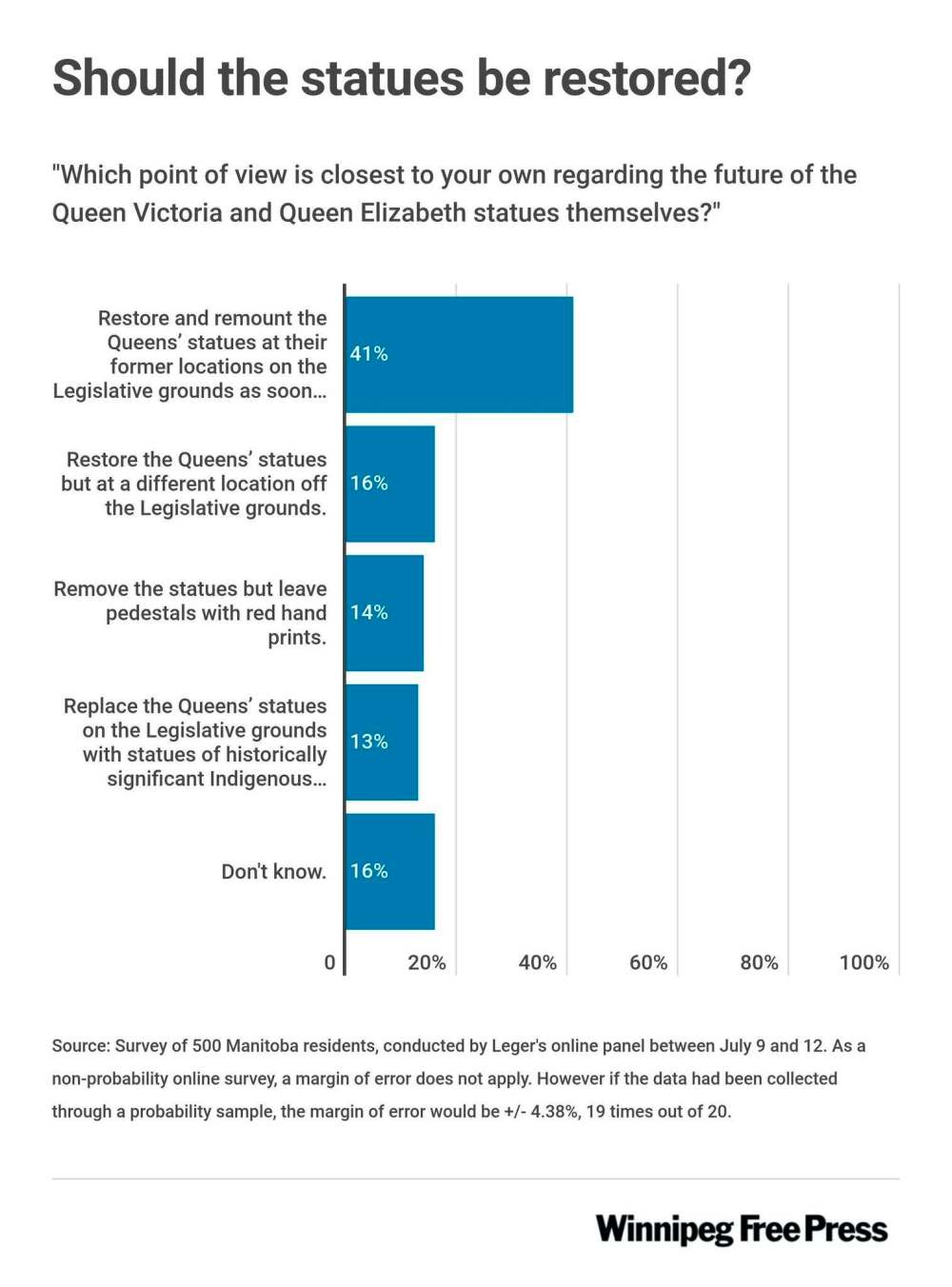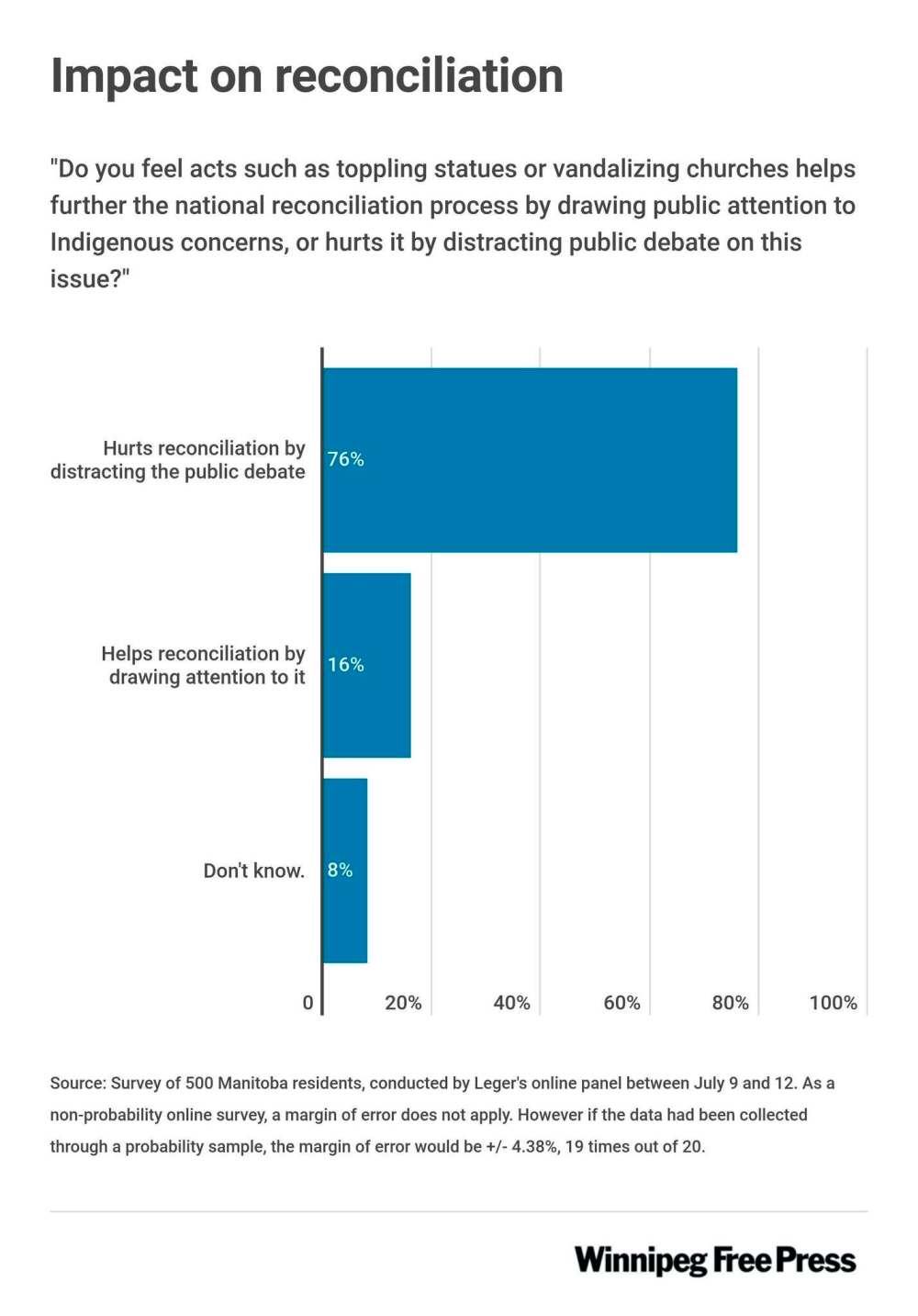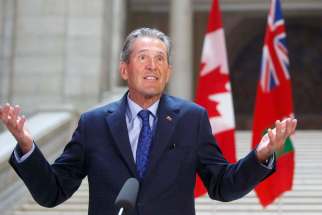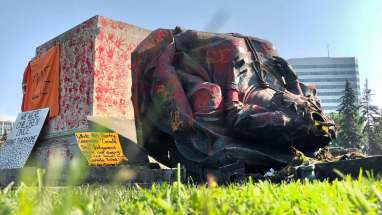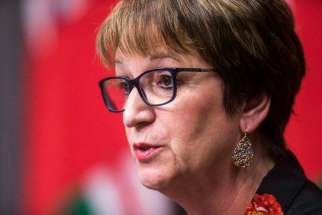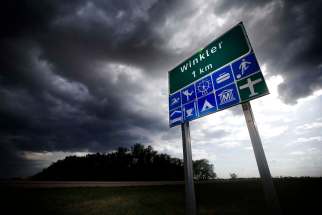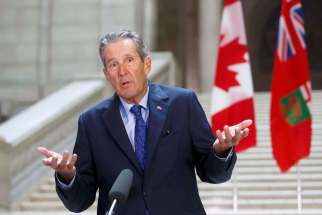Toppling Manitoba monuments ‘hurts reconciliation process’: poll
Read this article for free:
or
Already have an account? Log in here »
To continue reading, please subscribe:
Monthly Digital Subscription
$19 $0 for the first 4 weeks*
- Enjoy unlimited reading on winnipegfreepress.com
- Read the E-Edition, our digital replica newspaper
- Access News Break, our award-winning app
- Play interactive puzzles
*No charge for four weeks then billed as $19 plus GST every four weeks. Offer only available to new and qualified returning subscribers. Cancel any time.
Read unlimited articles for free today:
or
Already have an account? Log in here »
Hey there, time traveller!
This article was published 15/07/2021 (1259 days ago), so information in it may no longer be current.
A new poll appears to bear out Indigenous leaders’ worries the recent toppling of statues in Winnipeg could undercut moves towards reconciliation and take focus away from discoveries of hundreds of unmarked graves at former residential schools.
In a survey conducted by Leger for the Winnipeg Free Press, 76 per cent of Manitobans believe acts such the Canada Day protest of tearing down monuments to Queen Victoria and Queen Elizabeth II “hurts the reconciliation process by distracting the public debate.”
Only 16 per cent said they believed it would help by drawing attention to reconciliation matters.
Nearly half of respondents (48 per cent) said the act “was completely wrong and any damage or vandalism of public property should not be tolerated.” Thirty-eight per cent said: “I can somewhat accept why it happened. I prefer that public property is not vandalized, but I recognize the frustration that led to these acts of protest.”
Meanwhile, 41 per cent of Manitobans would like to see the statues restored and put back into their original locations as soon as possible; only 13 per cent want the statues of English monarchs replaced with ones featuring historically significant Indigenous leaders.
Andrew Enns, Leger executive vice-president, said he wasn’t surprised by the numbers.
“For most people, they still see a lot of lawlessness in this,” said Enns. “For a lot of people, I don’t think it helps things.”The toppling of the two statues on the Manitoba legislature grounds made headlines around the world.
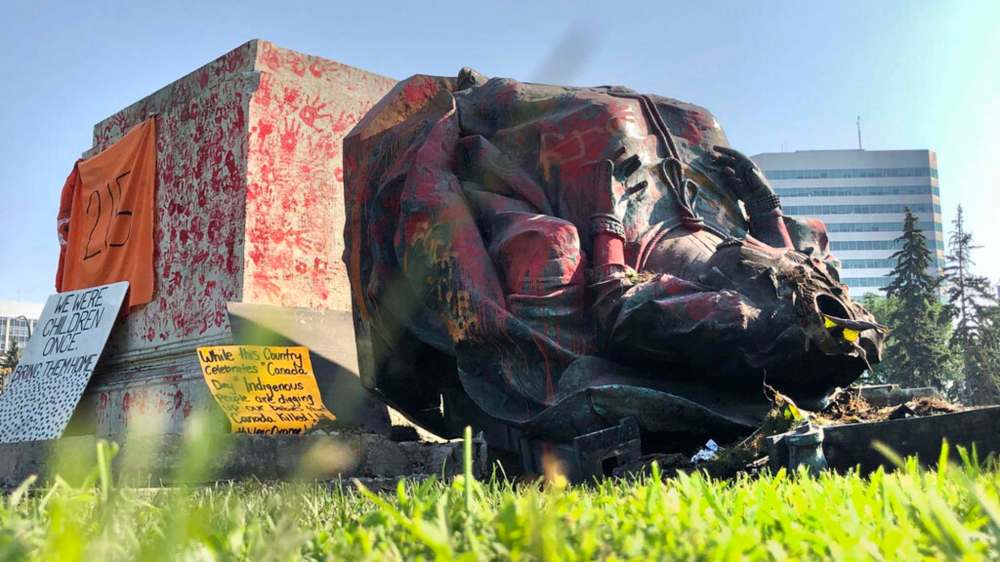
During marches on Canada Day calling attention to unmarked graves found at former residential school sites, some broke off from the main group, put ropes around the statues and pulled them to the ground.
While the Queen Elizabeth statue was then left alone, the Queen Victoria monument was covered with handprints in red paint and its head cut off and thrown into the Assiniboine River. It was later recovered by a kayaker.

Former senator and chairman of the Truth and Reconciliation Commission of Canada Murray Sinclair said the people who toppled the statues didn’t represent the views of the people most affected by residential schools.
“The survivors haven’t called for the destruction of monuments. They’ve called on protesters to stop damaging public places. They know that it demeans them… the survivors know they are on the side of the angels. Their cause is a high cause. The people who go out and commit criminal acts is demeaning to the survivors,” he said this week.
“The survivors do not want it. This does not move the conversation about reconciliation one iota.”
“The survivors haven’t called for the destruction of monuments. They’ve called on protesters to stop damaging public places. They know that it demeans them…”
– Murray Sinclair
Sinclair said he believes the majority of Canadians are trying to find a way of being conciliatory and reconciliation is moving forward.
However, just putting the old statues back “would be as if nothing happened,” he said. “It would be like an act of provocation.”
Sinclair said the provincial government should instead talk to both Indigenous leaders and residential school survivors about what they would like to see in those places.
“Let’s take advantage of the moment to create something that shows the First Nations and the Crown as equal. I think we can come up with a concept which respectfully represents what our history is.”
David Chartrand, Manitoba Metis Federation president, said the FP/Leger poll numbers don’t surprise him.
“My position is: it is not right what they did,” said Chartrand. “People just got carried away and it was a very small group of them. But the intention (with the marches) was to send a message that children mattered and we need to talk about reconciliation.
“You just destroyed everything this march was about and turned the story away from that issue.”
“At the end of the day, we do a poor job of telling our stories… Now is the time.”
– David Chartrand, Manitoba Metis Federation president
While Chartrand believes there is a place on the grounds for the two queens, there should be more Indigenous statues to show the full history of the province.
“At the end of the day, we do a poor job of telling our stories,” he said. “Now is the time.”
Robert Finch, chairman of the Monarchist League of Canada, said the poll numbers are what he would have expected.
“There is definitely a feeling that these sorts of actions really risk the whole reconciliation process,” said Finch. “Vandalizing a statue of Queen Victoria or Queen Elizabeth II isn’t going to help one bit in healing old wounds, quite frankly. All it does is create further division.”
Finch said nowhere in the TRC final report is there a call for ending the monarchy in Canada.
“Just as in the broader population, Indigenous opinion on the monarchy is far from being universal,” he said. “Some support it, some do not, and some don’t care.”
The poll of 500 Manitobans was conducted through a survey using Leger’s online panel July 9-12. If the information had been collected by a probability sample, the margin of error would have been plus or minus 4.38 per cent, 19 times out of 20.
kevin.rollason@freepress.mb.ca

Kevin Rollason
Reporter
Kevin Rollason is one of the more versatile reporters at the Winnipeg Free Press. Whether it is covering city hall, the law courts, or general reporting, Rollason can be counted on to not only answer the 5 Ws — Who, What, When, Where and Why — but to do it in an interesting and accessible way for readers.
Our newsroom depends on a growing audience of readers to power our journalism. If you are not a paid reader, please consider becoming a subscriber.
Our newsroom depends on its audience of readers to power our journalism. Thank you for your support.


